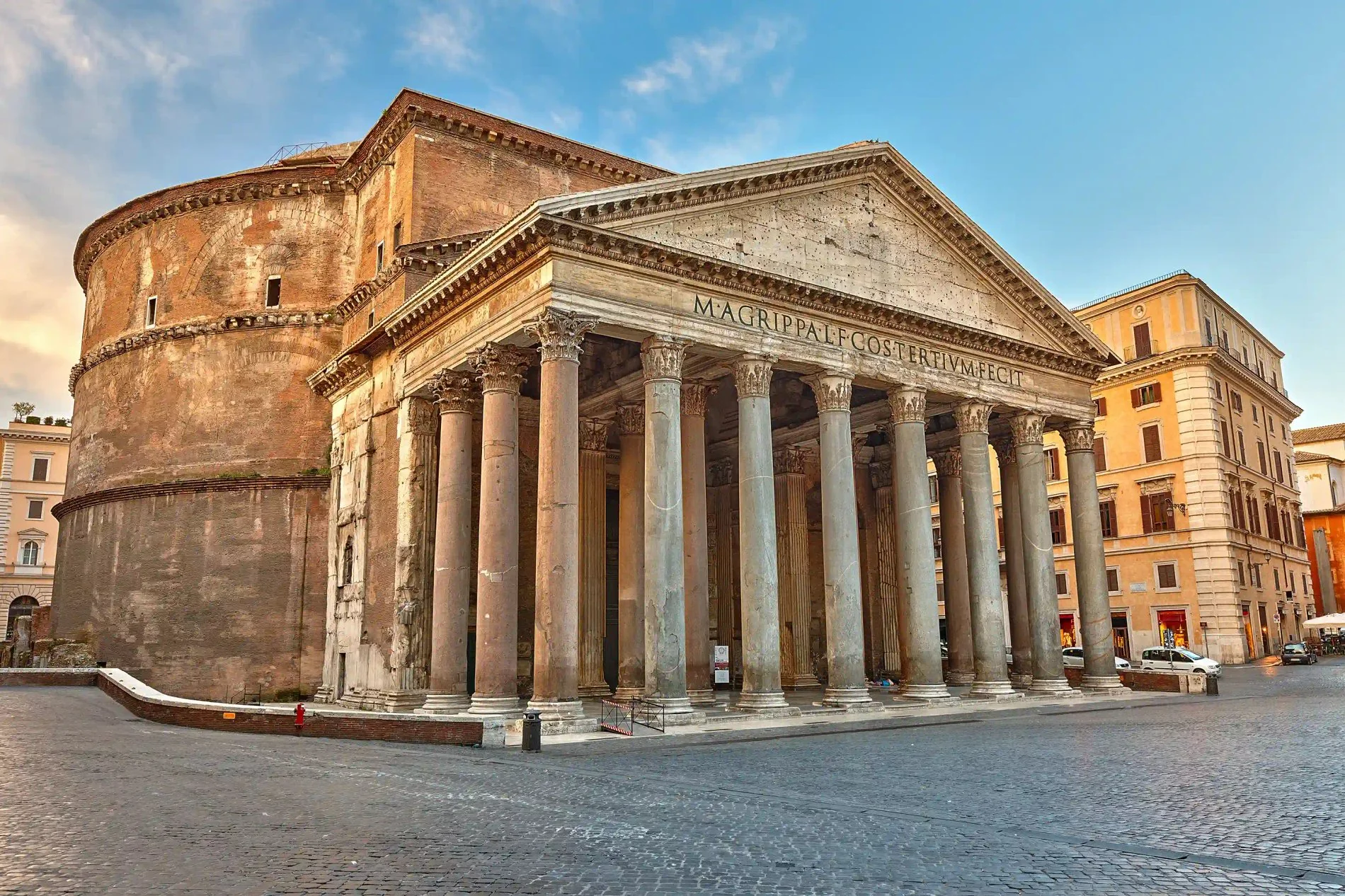Pantheon
This is a temple dedicated to various deities, especially the God Mars, founder of the city of Rome. After a fire in the early 2nd century, it was restored and rebuilt. In 608 AD, the Pope received it as a gift and converted it into a Christian church, as it stands today. One enters through a rectangular porch, featuring 16 columns, leading to a vast circular space beneath one of the world's most beautiful domes. Gazing up at the intricacies of this dome can almost induce dizziness. The tomb of the famous painter Raphael is also housed within.
The Pantheon in Rome, a marvel located just a short walk from 9Hotel Cesàri
Its preservation is impeccable, and its ongoing use has maintained it in excellent condition. The Roman expertise was unparalleled; they mastered the production of cement and concrete that hardened over time. A full tour will take about an hour, and the staff at 9Hotel Cesàri are at your service to provide information.
Origins of the Pantheon
The Pantheon in Rome has fascinated visitors for centuries. Originally built as a temple dedicated to multiple deities, notably Mars, it's considered a prime example of ancient architecture. Restored after a 2nd-century fire, by 608 AD, it had been gifted to the Pope and transformed into a Christian church.
The Pantheon was built during the Roman Republic, marked by significant economic, cultural, and political expansion. Romans were renowned for their architectural, engineering, and artistic prowess, leaving behind iconic structures like the Colosseum, Circus Maximus, and Roman Forum.
The entrance features a rectangular porch with 16 columns, leading inside to the grand circular space below a magnificent dome. So breathtaking is the dome that visitors may feel dizzy admiring its details. Colorful frescoes and mosaics on the inner walls further accentuate its beauty.
The Pantheon is also the resting place of the famed painter Raphael, making it a pilgrimage site for art and history enthusiasts. Its exceptional preservation showcases the Romans' unparalleled craftsmanship in cement and concrete production, which hardens over time.
The Pantheon: From Temple to Basilica
 Its transformation from a temple for gods to a Christian worship site reflects the religious and political shifts in Rome. Initially dedicated to multiple deities, it served as a place for Romans to pray and offer sacrifices. Temples were integral to Roman religion.
Its transformation from a temple for gods to a Christian worship site reflects the religious and political shifts in Rome. Initially dedicated to multiple deities, it served as a place for Romans to pray and offer sacrifices. Temples were integral to Roman religion.
However, with the adoption of Christianity as the Empire's official religion in the 4th century, many changes transpired. Roman emperors promoted Christianity, gradually phasing out pagan practices. Pagan temples either closed or converted to Christian churches.
The Pantheon underwent a significant transformation in the 6th century. In 608 AD, Byzantine Emperor Phocas gifted it to Pope Boniface IV, who consecrated it to the Virgin Mary and all Christian martyrs. This marked Rome's transition to Christianity.
Converting the Pantheon necessitated architectural and liturgical modifications. Christian altars were introduced, biblical scenes adorned the walls, and pagan statues were replaced with Christian figures. Yet, its signature dome remained untouched.
This conversion illustrates how architecture and worship places were repurposed to accommodate evolving religious beliefs. It was common, as church authorities sought to consolidate influence and convert pagan populations.
Today, the Pantheon remains an active Catholic church, hosting religious ceremonies and welcoming visitors keen to appreciate its architecture and history.
A Must-Visit in Rome, Only 300m from 9Hotel Cesàri
Exemplifying Roman classical architecture, the Pantheon's features include columns, arches, and its renowned dome with an oculus. This opening illuminates the structure, adding to its allure.
The Pantheon's Famous Dome
The dome of the Pantheon in Rome is one of the most striking and iconic architectural features of this monument. It is widely regarded as a masterpiece of engineering and architecture from the Roman era.
The Pantheon's dome has several unique attributes that make it a remarkable achievement. First, it boasts a hemispherical shape, meaning it resembles half of a sphere. This gives the Pantheon a commanding and harmonious appearance while creating a spacious and open interior.
The dome spans 43.3 meters in diameter, making it the largest unreinforced concrete dome in the world. At the time of its construction, the Romans were among the foremost experts in concrete usage, leveraging this skill to craft astounding architectural structures.
What makes the Pantheon's dome even more impressive is the presence of an oculus, a circular opening at the dome's apex. The oculus, 8.8 meters in diameter, allows natural light to flood the building's interior. This opening creates a striking effect, casting bright, shifting light onto the Pantheon's walls and floors throughout the day. Furthermore, the oculus also serves as a natural ventilation device, allowing air to flow and helping maintain a pleasant atmosphere inside.
Constructing the Pantheon's dome was an engineering marvel for its time. The Romans employed a concrete mixture of lime, pumice, and volcanic ash, which solidified over time to form a robust and enduring material. Layers of concrete were strategically placed using formwork to support the structure during construction. This construction technique enabled even distribution of the dome's weight and reinforced its stability.
Remarkably, the Pantheon's dome has remained intact for over 2,000 years, despite weathering, earthquakes, and historical events. This attests to the exceptional quality of Roman engineering and their mastery in building enduring structures.
Today, Pantheon visitors can closely admire the dome's grandeur. The view from inside is breathtaking, with intricate patterns and architectural details soaring towards the heavens. It's a unique experience to stand at the Pantheon's center, look up, and marvel at the dome seeming to hover above.
Beyond its architecture, the Pantheon also holds significance in art history. It has been the venue for numerous exhibitions, ceremonies, and various cultural and religious events. Over the centuries, the Pantheon has served diverse purposes but has remained a symbol of Rome's cultural and historical richness. It has undergone multiple restorations to preserve its integrity and beauty, making it impeccably preserved even today.
The Pantheon exemplifies the global impact of Roman culture. Its design and architecture have inspired countless buildings throughout history, including Christian churches and royal palaces. It stands as a masterpiece of classical architecture and a testament to the grandeur and might of the Roman Empire.
For tourists and travelers visiting Rome, the Pantheon is a must-visit attraction. It's located just a short walk from the 9Hotel Cesàri, and their staff are on hand to provide insights on how best to enjoy your visit. A comprehensive tour takes about an hour, granting you the opportunity to explore the architecture, art, and history of this amazing edifice. Notably, while entrance is currently free, this won't be the case for much longer as plans for an admission fee were recently announced.
Afterward, continue your exploration of Rome's pedestrian streets, especially since the Trevi Fountain is also nearby the Pantheon and the hotel.
In conclusion, the Pantheon in Rome is a captivating edifice that warrants a visit. It showcases Roman ingenuity and craftsmanship and highlights their culture's influence worldwide. Its outstanding preservation and continued relevance make it a unique destination during your Roman holiday. So, don't hesitate to experience this classic architectural and historical gem.


